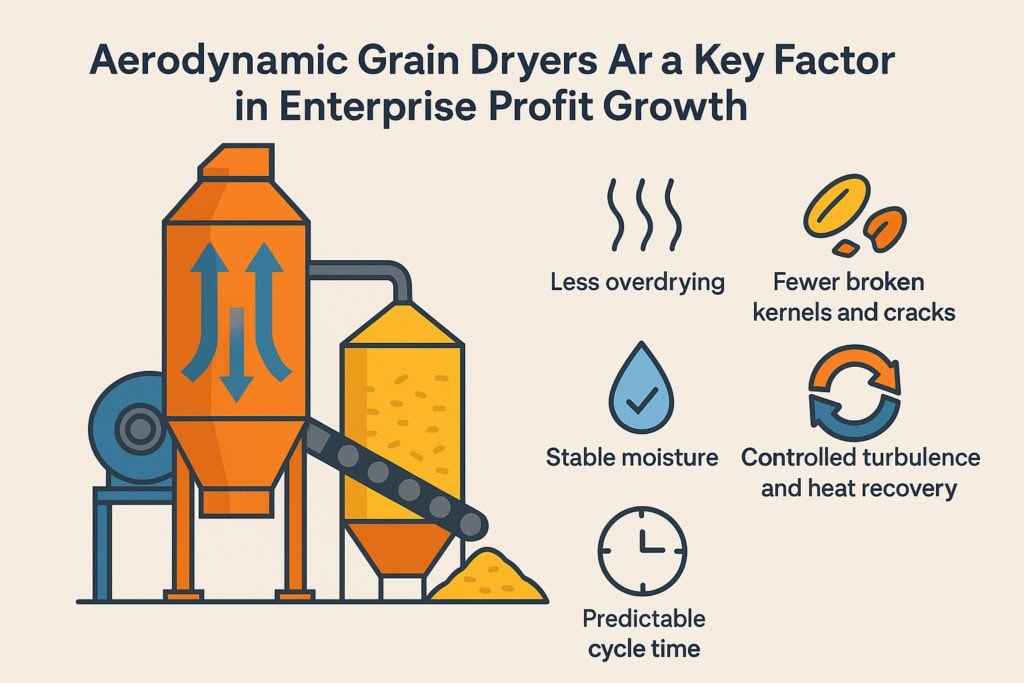Grain drying is not the end of the season—it is the point where margin is formed. Loss of weight, unstable moisture, and penalties at delivery eat profit faster than market price fluctuations. Aerodynamic grain dryers, which control air and heat flows without “dead zones”, deliver predictable results batch after batch. As a result, the enterprise not only saves energy, but stabilizes quality, increases the share of premium classes, and frees up logistics capacity during peak days.
How Aerodynamics Works—and Why It Affects Money
In conventional systems, air often moves unevenly: some of the grain gets overdried, while another part is “underworked”. Metra aerodynamic dryers create controlled turbulence and uniform heat transfer, so moisture is removed consistently throughout the entire grain layer. This reduces unproductive over-drying, the risk of microcracks and mechanical damage, and preserves commercial appearance.
The second component is stable output moisture. When indicators do not “swing”, the batch passes the lab without risk and avoids discounts. For corn, even +0.5–0.7% of preserved mass per 1,000 tons is tens of tons directly multiplied by price; for wheat, it is often the chance to move into a higher class thanks to better conditioning.
The prerequisites for economic efficiency are laid already at the stage of mode control: the precision of temperature maps and air duct pressure makes it possible to quickly switch between “intensive” drying and gentle moisture removal without restarts or idle hours.
This is where direct economic gains are born:
- Less overdrying thanks to uniform dehydration across the entire layer.
- Fewer broken kernels and cracks—and therefore a better yield of full grain.
- Stable moisture—minimal penalties or downgrades at delivery.
- Controlled turbulence and heat recovery lead to lower cost per ton-percent.
- Less self-heating and mycotoxins in storage due to proper drying and cooling profiles.
- Predictable cycle time helps synchronize the process with harvesters and truck logistics.
And this is far from the full list of advantages gained by the owner of such modern equipment.
Process Economics and How to Choose the Right Solution
Financial result is shaped not only by fuel price, but by the stability of efficiency in different weather windows, start/stop speed, and transparency of control. Aerodynamic dryers maintain efficiency at night, during the day, and under high humidity—which makes shipment planning manageable: you can catch “premium windows” of the market instead of dumping batches just to free storage.
Modularity is another advantage. You can add sections without a full elevator reconstruction, scaling throughput according to the harvest of a specific year. Digital batch logs and remote diagnostics simplify audits, certification, and work with counterparties.
Equipment Selection Criteria
To make the investment justified, you should not choose based solely on model price. Here is a short checklist to choose correctly:
- Aerodynamic design of shafts/chambers — no “dead zones”, correct flow velocity.
- Automation—temperature/moisture sensors by zones, drying recipes, LMS/SCADA integration.
- Heat recovery and insulation—confirmed by field measurements, not only by documentation.
- Serviceability—access to key units, maintenance without line shutdown.
- Aspiration & fire safety—spark suppression, dust control, compliance with elevator standards.
In other words, an aerodynamic grain dryer is an investment in controlled margin: lower energy cost per ton-percent, less overdrying, stable quality, and faster inventory turnover. Over a season with volumes of 300,000 bushels of corn, the combined effect from fuel savings, preserved mass, and class premiums easily reaches hundreds of thousands of dollars. When drying becomes predictable, the enterprise eliminates bottlenecks, works the market proactively, and recovers the investment in 2–4 seasons—depending on tariffs, crop type, and utilization.





Leave a Reply